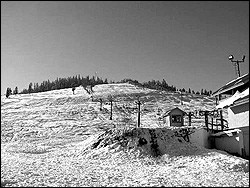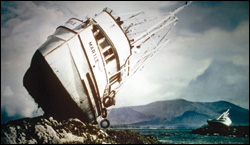“We’ve had a disastrous visit from the Pineapple Express,” read a dour group e-mail issued Dec. 12 by The Summits at Snoqualmie. The author had draped his words as though informing of a death. A 30-inch snowpack on Snoqualmie Pass had been reduced to 3 slushy inches over two days of unseasonably warm rain Dec. 9–10, and a ski season that typically opens the first weekend in December was pushed back, with no opening in sight. The Summit, of course, isn’t known for phenomenal snow early or late in the season, but Stevens Pass and Crystal Mountain also lost snowpack during that December rain.
It’s been colder in the Cascades recently, and Crystal has been open a couple of weeks, but snow depth is still meager— 16 inches this week at Crystal’s base. The mountains that are open, including Crystal and 49 Degrees North, near Spokane, are operating with limited terrain and partial staffs, though 49 Degrees North has almost all its runs open. Stevens Pass and Mission Ridge opened just this week, but not all runs. And three weeks after the usual opening date, in the midst of the holiday vacation period, the base at Snoqualmie this week was a mere 12 inches. Neither The Summit nor White Pass had opened, leaving many season-pass-holders upset and some even worried about the possibility of global warming finally catching up with a treasured sport and multimillion-dollar industry. Does the lack of snow signal the beginning of the end?
Over a season that typically lasts a little more than 100 days a year, two or three weeks can make the difference between red and black. Shops like Mount Pilchuck Ski and Sport in Everett are reporting a 25 percent to 30 percent drop in sales, with no sign it will pick up. December is usually the busiest month. Most retail shops expect a third of their yearly income during December, with another third from January through March. “It’s been slow,” admits a manager of the Alpine Hut in Seattle. Other shops, such as Seattle Ski and Snowboard, report little or no change and owe their good fortune to families taking holiday vacations to resorts in British Colombia or Colorado.
Slow equipment sales or not, it’s the seasonal employees of the resorts who are in the worst shape, such as the 1,100 people waiting patiently to start work at Snoqualmie. They are unable to collect unemployment insurance and must find other ways of getting by until the snow falls. Heath Kocan, 26, a sometimes- Seattle resident who left in November for a job at Schweitzer Ski Resort in Idaho, was laid off two weeks ago due to a lack of snow. He now washes dishes at a Sandpoint restaurant, waiting patiently to get work on the mountain again.
Mount Baker, of course, where winters are fiercest, is an anomaly. It’s operating with a 52-inch snowpack at the summit and all lifts running. Neither Whistler/Blackcomb in British Columbia nor Sun Valley, Idaho, can match that.
But the good news is this: This winter’s late start is a fluke. There’s no need to worry. It could simply be a lighter snowfall generally seen in El Niño years such as this. Even if the snow drought lasts into January, there still would be nothing to suggest a global warming–type trend in the Cascades. Looking over snowpack levels and opening dates from the past two decades shows light years and heavy years but little pattern. It was just five seasons ago that Mount Baker recorded 1,140 inches of snow in a single season, more snow than has ever fallen on any ski resort anywhere. Opening dates at Crystal have ranged from a January opening in 1991 (after a November start and close) to a Nov. 20 opening, a record set last year. The Summit at Snoqualmie and Stevens Pass opening dates read the same way. Next year could very well start before Thanksgiving.
But for now, the shop owners, the lifties, the rental-shop techies, the food servers, the hotel clerks, and, yes, the skiers and snowboarders must be patient. The skiing season arrives when it arrives, and the industry brushes itself off.





